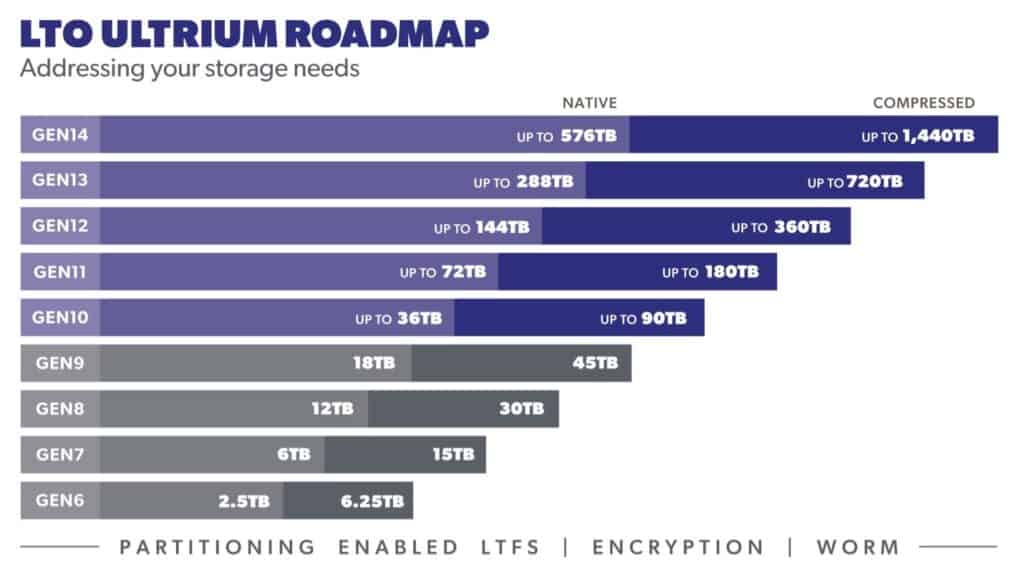
Reflecting on World Backup Day coming up on March 31st, I recall coming across the following quote that recently appeared in an industry newsletter from an IT executive that said:
“For years IT administrators have worked hard to back up an increasing tsunami of data, and with each passing year, that has become harder to manage. In some cases, backup has been abandoned altogether. That is a precarious place to be.”
Indeed, a very precarious and dangerous place to be considering the increasing value of data for data-driven organizations. Today’s modern and highly advanced data tape systems can help solve the problem.
Here are five of the top reasons why tape should be part of the backup process:
Studies by industry TCO and sustainability expert Brad Johns Consulting compare the long-term cost of tape, disk and cloud storage. For example, the ten-year total cost of ownership (TCO) of 10 PB of storage (with capacity growing at 35% annually) estimates a tape solution to be $1.9 million versus $8.8 million for the disk storage solution. That 79% reduction means that anyone with PB class storage is simply wasting money if they try to retain it all on disk. The math works out similarly when sending data to the cloud. Tape is far cheaper than the cloud when large amounts of data are being retained for long periods even with minimal retrieval of that data. No wonder many of the hyperscale cloud service providers are users of tape.
According to George Crump of Storage Switzerland, the size of most backup repositories is about 10X that of the amount of production data. A big reason why is that most companies keep backup data for at least five to seven years. Yet 95% of recoveries take place within the first 10 days. Thus, organizations are storing a lot of data on expensive, energy-intensive disks that will never be reaccessed. That data still needs to be retained for legal, analytics, or data protection purposes. The best approach is to continue to back up current data to disk and offload older data and backups to tape. This works particularly well for data that has a longer recovery time objective (RTO). This strategy can bring about as much as an 80% reduction in disk capacity requirements, lowers costs, and adds resilience as backups now reside on two different media. Check out the video below where George maps out the use case and advantage of tape for backups, now more relevant than ever:
The LTO generation 9 specifications include multi–layer security support with hardware–based encryption, immutable WORM (Write–Once, Read–Many) functionality, and fast data access with both the Linear Tape File System (LTFS) and Recommended Access Order (RAO). By retaining tape cartridges offline and completely disconnected from the network, they are immune to ransomware attacks and other unauthorized access. By establishing a tape “air gap”, hackers have no network connection they can use to infect files. This provides much-needed insurance against ransomware infection. With disk-based backup, there is always a chance that cybercriminals can infect those files as they remain online.
The IT world has always had a fixation on new shiny objects. While tape technology has been around for 70 years, it has constantly evolved over the decades. Today, a single LTO-9 tape cartridge can hold 45 TB of compressed data (18 TB native). This represents a 50% capacity boost over LTO–8 and a 12X increase over LTO-5 technology launched a decade or so ago. Transfer speeds are now considerably faster than even HDDs at 400 MB/s (native), and 1,000 MB/s (2.5:1 compression). On top of recent gains with the release of LTO-9, the roadmap for further LTO innovation includes doubling capacity for each new generation. That equates to 40% per year capacity growth for tape for the foreseeable future with little or no areal density challenges compared to HDD technology.

With data centers consuming around 2% of all electricity in the United States and storage (the vast majority of it from hard disk drives) consuming about 20% of total data center power, something must be done to change the equation in light of the growing global warming and climate change concerns. Tape basically only uses power when data is being actively read or written. A tape cartridge on a shelf or sitting idle within a tape library slot consumes no power. Moving cold and inactive data from disk to tape can bring about a 97% reduction in carbon emission, according to recent studies.
Some worry that if they need to recover files retained on tape, it will take too long. The worst-case scenario is that it might take a day to retrieve a cartridge and ship it back onsite. But leading organizations in life sciences, research, digital evidence, and media and entertainment are harnessing the latest active archive solutions to keep all data online all the time so it can be recovered far more rapidly. Restoration of objects or files can be done in a matter of minutes. Active archiving is being used for capacity management to remove colder data from backups thus improving system performance while ensuring data preservation. An active archive takes advantage of tape’s low cost, high capacity, longevity, and portability so that massive volumes of data can be moved from primary storage and maintained online all the time for easy end-user access. Additional copies of data can be moved offsite for the benefit of air gap security.
On this World Backup Day, why not avoid precarious and dangerous places, and reevaluate the usage of tape in your backup and active archiving processes?
